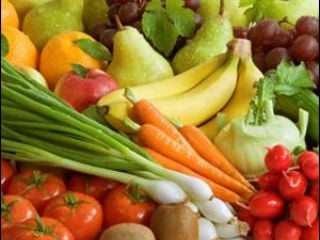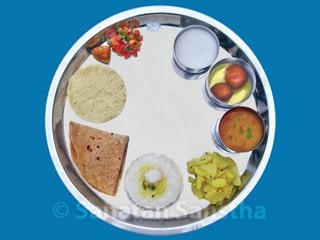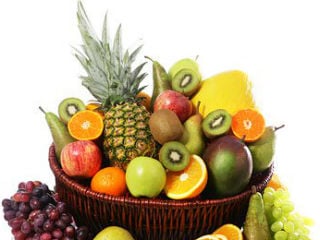Achars associated with meals can mainly be divided into three – achars to be followed before, during and after a meal. Traditionally in Hindu Dharma, food is served by others; but under the influence of western customs and a hectic lifestyle, this tradition is gradually diminishing. However, the method of others serving food still remains the appropriate method, complete from every perspective. Achars to be followed before a meal and associated aspects are described in this article by focusing on this method of serving food.
1. Performing ‘Vaishvadev’
The first karma to be performed once food is cooked is ‘Vaishvadev’. The scientific method of performing Vaishvadev and the associated mantras should be learnt from the family priest.
1 A. Performing ‘Vaishvadev’ for
nullifying the violence that takes place unknowingly
Many organisms are killed when we sweep the floor and when we light the stove used for cooking food. It is essential for a householder to take atonement daily for physical and subtle killing of the creatures that takes place unknowingly. ‘Vaishvadev’ is performed to nullify the effect of such violence. Food purified by the ritual of ‘Vaishvadev’ is essential for keeping the body and the mind in a pure state; therefore, eat food only after it has been sanctified by the ritual of ‘Vaishvadev’.
2. Offering Naivedya to the Deities, serving food
to a cow on a banana leaf and placing kakabali
- After the ‘Vaishvadev’, offer Naivedya to the Deities.
- Serve food to a cow on a banana leaf. Thereafter, place some portion of the food as kakabali for ancestors outside the house.
- The Naivedya offered to the Deities is served to someone present for the meal.
Underlying science
- Man is able to perform all the activities on the strength of Divine Energy and Knowledge, meaning, only with the grace of God. Naivedya is offered to God with a bhav (Spiritual emotion) of gratitude that ‘God Himself is the doer and it is He who gets all the things done. I can do nothing without Him. I have received this food with His grace. Therefore, let me offer whatever I have received to God first, who is the bestower’.
- When food is offered to the Deity as Naivedya and then partaken as Prasad (Holy sacrament), we benefit from the Deity Principle and Chaitanya (Divine consciousness).
3. The place for eating
The kitchen is the best place for eating. If it is not possible to sit there, sit in another room for eating. The dining place should be clean and must have a cheerful environment. Do not eat in the open, under the sun, under a tree, in a dark room and in the bed room.
4. The direction to face while eating
Whenever possible, sit facing the east or west while eating. Avoid facing the north if possible; but never ever sit facing the south while eating. If there are rows of people eating together and if they are sitting in rows facing all the four directions, then those facing the north and south should eat while chanting God’s Name.
Face the east while eating
The direction east is complimentary to Tej (Absolute Fire Principle). Eating is very much a Yadnyakarma. When this Yadnyakarma is spread into the body with the help of the energy of Tej in the direction east, it helps speed up the process in an appropriate manner.
Never eat facing the south direction
Since there is predominance of Yama waves in the south direction, we should not contaminate food by sitting in impure area of Raja-Tama-predominant waves. Since there is likelihood of distress being caused by dissatisfied souls when food charged with Yama waves is eaten, it is a rule that we should not eat facing the inauspicious south direction.
5. Wearing a sattvik attire
Man should preferably wear a silk sovale. He can wear a pancha or a dhoti around the waist and cover shoulder with a pancha or uparne as a secondary garment. If both of these are not possible, men should wear either dhoti-kurta or pyjama-shirt. Do not wear shirt, pant, cap, etc. while eating. Women should wear a nine-yard or six-yard saṛi. If not a saṛi, they should wear kurta-pyjama.
6. Washing the face, hands
and feet before eating food
Before sitting to eat, wash the face, hands and feet; rinse the mouth with water thrice and sit with the wet feet. The face, hands and feet should be wet while eating food, since this increases the life span.
6 A. Science underlying the act of
washing the face, hands and feet before eating food
- Washing the face, hands and feet before eating food helps in removing the particles of dust on them.
- When food is eaten with the hand that has dust particles on it, the Raja-Tama-predominant waves emitting from Patal (Hell region) and from the environment get attracted to the fingers and spread into the food. Having such food is likely to cause distress due to negative energies.
6 B. Rinsing the mouth thrice before and after eating
- Subtle Raja-Tama-predominant waves or gases emanate from desire-oriented sheath of an individual and get stored in the void of the mouth. ‘Vaman’ of these gases occurs, meaning, they are eliminated through the medium of water by rinsing the mouth before eating.
- While eating, through the movement of intestines, subtle waste gases are emitted by the internal body cavity. To expel these gases through the medium of water by rinsing the mouth after eating, ‘daman’, meaning, the second cleansing of the mouth is performed.
6 C. Washing the feet before eating
- Washing the feet destroys the Raja-Tama particles in the dust on the feet. Besides, due to the presence of the Apatattva (Absolute Water Principle)-predominant waves in water, the pranamaya-kosha (Vital energy sheath) gets activated on washing the feet. This is followed by praying & then eating. Consequently, the ability of the body to receive sattvik waves from the universe while eating is enhanced.
6 D. Eating while the feet are wet
- Eating while the feet are wet means completing the Yadnyakarma of eating with the help of a completely pure body and mind. Contact with water increases the sensitivity of the body. Therefore, waves that contain Chaitanya obtained from the food eaten as Prasad rapidly spread into the entire body in a very short period. These waves also create a protective sheath around the body.
7. Why should we sit on a wooden seat for eating?
Do not use plastic or steel seats. If a wooden seat is not available, use seats made of either cotton or silk. If this is also not available, use a small mat.
- When food is eaten while sitting directly on the floor, the body comes into contact with the earth, and the distressing upward moving waves emitted by the earth spread into the body through the toes. A wooden seat has movement of Tejtattva-predominant waves in a subtle proportion. Movement of these waves creates hot energy. This energy blocks the distressing waves emanating from the earth and disintegrates the Raja-Tama-predominant particles carried by these waves and thus, they do not affect the individual.
- Sattvik waves emanating from earth accumulate in the shape of the wooden seat. In this process, the distressing waves emitting from Patal are obstructed. Sitting on a wooden seat charged with sattvik waves helps increase the movement of Sattva particles in the pranamaya-kosha of the individual.
8. Why should rangoli be not drawn around
the wooden seat of the individual who is eating?
Since food is considered to be a form of Brahman (Absolute God Principle), drawing rangoli around the plate is akin to respecting the divinity in the food. The individual eating is the one who has surrendered to this divinity; hence, it is incorrect to draw rangoli around the wooden seat on which he sits. It is appropriate to draw rangoli around the wooden seat of an individual who is undergoing rituals during religious occasions such as birthday celebration and Bhaiduj. This is because the divinity in that individual gets activated after performing aukshan and praying. Hence, drawing rangoli around the wooden seat of that individual is akin to respecting the divinity.
9. The plate or leaf on which the food is served
Wipe the plate (or leaf) clean and keep it on a rectangular stool in front of the wooden seat. If a wooden seat is not available then draw a square using a spoonful of water (Called a manḍal) on the floor and keep the plate (or leaf) on it. Each side of the square manḍal drawn with water should be of a length equal to the distance between the thumb and index finger or the thumb and little finger when they are fully stretched. Under no circumstances, place the leaf or the plate and bowl directly on the floor.
Gold or silver-plated crockery is the best, while brass crockery is mediocre in nature.
Importance of banana leaf
Eating food served on a banana leaf while sitting on a wooden seat bestows health. Banana leaf is Holy, contains Chaitanya and is Divine. Regularly eating food from a banana leaf creates an invincible protective sheath around the individual.
10. How should the plate or leaf be placed?
Given ahead are the two ways of deciding the position of a plate or leaf.
Method 1 – Placing the plate containing food on the floor
When we eat by placing the plate containing food on the floor, it helps us imbibe bhumi-lahari (Earth waves) through the medium of food. This activates the subtle-gases emitted by the food from which the body benefits, and this help in increasing the prana-shakti.
Method 2 – Placing the plate with food
at a level higher than the individual’s level of sitting
This amounts to respecting the God Principle in the food. Respecting the food thus awakens the Atma-shakti (Soul energy) of the individual.
Do not eat by placing the plate on the thighs
- Eating by placing the plate on the thighs amounts to insulting the inherent divinity in food and consequently, the expected benefit of sattvikta in it (a form of Brahman) is not obtained.
- Upon contact with the feet, the distressing vibrations emanating from Patal make their own seats in the voids of the knee joints. When food is eaten by placing the plate on the thighs, these dormant vibrations in the feet, knees and thighs get activated, and the food can become impure.
11. Method of placing a
banana leaf for serving food
The stem of a banana leaf has greater ability to attract the bhumi-lahari, while the tip has greater ability to emit sattvik waves. Therefore, the tip of the leaf is in front while eating. These waves help reduce the proportion of Raja-Tama components in the environment and create a sattvik protective sheath around the food. This helps reduce the distress caused due to negative energies through the medium of food.
If the banana leaf for serving food is placed horizontally to the individual eating, with its tip towards the right, the individual’s Suryanaḍi gets activated due to the sattvik waves emitting from its tip. Conversely, if it is placed straight with its tip towards the front, both sides of the body of the individual get the benefit of the waves emitted by the tip of the leaf, and this activates the individual’s Sushumnanaḍi. This maintains equilibrium of subtle gases in the body and helps keep the body healthy.
12. Drawing rangoli around the leaf or plate
Rangoli symbolizes auspiciousness. Auspicious components such as turmeric and kumkum used for colouring rangoli attract bhumi-lahari and Shakti-lahari (Waves of Shakti) from the environment and gather in the shape of the rangoli. These waves protect the food plate as per the requirement from the attacks of negative energies in the environment.
13. Lighting a sattvik incense-stick near the plate
Due to the effect of the fragrance of sattvik and fragrant incense-stick, Principles of Deities from the universe get attracted to the respective area. This brings about purification of the air and the area of activity. While enjoying food in such a Chaitanya-enriched environment, due to the spread of sattvikta into the body, the mind becomes cheerful. A cheerful mind is conducive to sattvik thoughts. It is on the strength of sattvik thoughts that an individual progresses spiritually.



 For healthy living avoid food that can cause antagonism due to contra-indications
For healthy living avoid food that can cause antagonism due to contra-indications Ill effects of artificial cold drinks
Ill effects of artificial cold drinks The connection between food and disease, important analysis on digestion
The connection between food and disease, important analysis on digestion The method of preparing rice is important !
The method of preparing rice is important ! Give up junk food and embrace Ayurveda
Give up junk food and embrace Ayurveda Should sweets be eaten at the beginning or end of a meal ?
Should sweets be eaten at the beginning or end of a meal ?
This awareness is essential for everyone who eats Satvik Food that is Prasad.